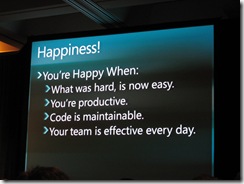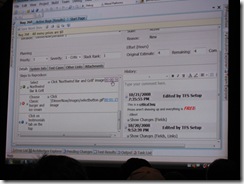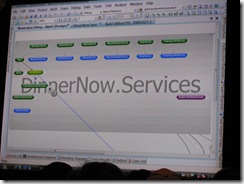Windows 7 is here...
 |  |
Steven Sinofsky (which report direclty to Steve Ballmer) talked about Windows 7. Here are the key messages from the presentation:
Windows 7 - A lap on User Interface
- Improvement on Task-Bar and Tray-Area (notification management and Jump-List) ;
- The wIndows are now dockable on the desktop and the UI seems a multi-user documents interface like Office clients;
- Libraries are groups of storage resources (external disks, folders, etc.) that could be aggregated from the search point-view and you can search items on a specifice Library (ie My Videos...);
- Home Groups are a set of shared resources that you can find and connect usually at home (printers, players, shared folders on NAS, etc,) to whose Windows 7 will automatically connect althouh if it's usually joined to a domain (like for a business laptop). Before Home Groups to get the same you need to write you own startup scripts;
- Device Stage "defines" the plumbing of a device and to which other devices could be connected. Also it's single management entry point for each device;
- You can play remotely an MP3 file or mpg video (right click and "Play to" with a list of target devices (players, MM devices, ...) ;
- Touch is definitevely the major improvement in the UI. I don't have an iPhone but should be the same but tailored to big screens;
- BitLocker extended to USB and external storage devices. BitLocker is a tecnology to encrypt and protect data on storage devices. Now it work also with solid state-memorie.
- VHD: It comes from Hyper-V, Windows 7 can manage different VHDs files and could be itself installed on a VHD because the boot manager can choose the image to start! I love this!
 | On the left the major improvements on Windows 7. The new version is not a breakthrough like Vista compared to XP, but appears to be a major review to Vista improving it accordingly to users feed-backs. Everybody at PDC has a lot of expectation about performances! |
 | On the left the Jump-List over the Task-Bar |
 |  Device Stage where there is a single point of management for each connected device to an hosting PC. Device Stage where there is a single point of management for each connected device to an hosting PC. |
 | A demo about Touch using new Home-PC from HP. You should think to an iPhone experience using a bigger LCD... Very interesting for Multimedia and obviously for Process Control Applications (SCADA) on plant production lines. Keep in mind: Touch was also supported by Vista but now it has been strongly enhanced in term of user experience (for example with multitouch). |
 | Windows 7 (the front-end) has been reengineered to stricly interact with Live Services (the users Cloud). |
 | About the transitions the driver model and the drivers are the same of Vista, so there will not be the issues as moving from XP to Vista about devices compatibility. |
 | Call to action fro developers, new features to be evaluated with an API:
|
 | The Windows 7 Development project drivers: Less memory foot-print and I/O to get more performance. I wanna see the improvement on registry access that is one of the worst bottleneck in Vista. |
 | The Pre-Beta is available now! I will evaluate if installing it on my laptop. Following there will be Beta 1, Beta 2 and RTM. The Pre-Beta will achieve the goals for performances but is not yet features completed. Some other minor improvements: The DLP integration and the extended desktop through Remote Desktop are great! For the first time in a Microsoft Presentation :-D Steven Sinofsky showed a switching on the DLP by a laptop and it worked (with all the people clapping). |
 | Call to Action for Developers! |
 |  Scott Guthrie explained why Windows 7 is a great platform for developers... Scott Guthrie explained why Windows 7 is a great platform for developers... But this message was built on user interface improvements. I should admit that DLP management and remote desktop extension are great for my job. |
 | A Demo from Auto-Desk in which they leverage Microsoft Surface to improve the user experience of designer. The demo was "cute" but I don't think that in real world application you can model your sketch with a finger... Maybe some application are feasible for fashion. |
 |  Obviously both .Net and C++ development environment are supported by Windows 7. Obviously both .Net and C++ development environment are supported by Windows 7. For C++ VS2010 is mandatory. For .Net the 3.5SP1 fw release is ready. |
 | .Net 4 is closer to be really available. Now there is CTP on a VHD for a first evaluation. A lot of improvement on WF, WCF and now Dublin is available (but I'll blog later about it). The idea is that you can host and MANAGE workflow processes. Dublin "de facto" is a WF application server. |
 | Extensibilty in VS2010, you can create your Extenston assemblies (for example to add features to the IDE and the editor like in the left picture) and deploy them just copying the DLL in the VS extension directory. No registration to be performed! |
 |  Very impressive demo from Tesco (the UK grocery market leader). They created a Windows 7 Gadget totally based on WPF which work with Touch experience to create a community of families, managing an agenda of deliveries and to leverage the webcam integrated in a pc to read the barcode and placing the order! Very impressive demo from Tesco (the UK grocery market leader). They created a Windows 7 Gadget totally based on WPF which work with Touch experience to create a community of families, managing an agenda of deliveries and to leverage the webcam integrated in a pc to read the barcode and placing the order! It was impressive. |
 | JQuery will be part of the development tools of Microsoft and it will supported by MS as an open-source project! JQuery is an lite JavaScript library that is one of the most popular libraries by web developer. In a very easy way you can interrogate (query) your html page so that is very usefull for creating Ajax applications. |
 | In a Visual Studio solution (2010) now you can have different configuration files for different targent environment (like development, staging, production for example). |
 |  Improved support from Visual Studio 2010 to SilverLight. Improved support from Visual Studio 2010 to SilverLight. Now a Silveri Light designer is included directly in VS (and VS itself is based on WPF) and a toolkit with some additional control for Silverlight is available here. |
 |  Live Services, using the new development platform is very easy to create Mesh applications tailored to consumer users. Live Services, using the new development platform is very easy to create Mesh applications tailored to consumer users. There is the Live Services framework (a .Net library) to create application in this environment More information about this world here. |
 |  A demo from BBC quite impressive. A demo from BBC quite impressive. An offline multimedia player based on SilverLight! It can interact with all devices having Live Mesh installed to share the users preferences. |
 | Office 14 is coming... We've as seen some very impressive demos about the integration of Office Online within Office for desktops to collaborate on documents (OneNote, Word, Excel) |
 |  In this demo over 2 concurrent PCs is possible to collaborate with OneNote using the PC client and the Online version at the same time! In this demo over 2 concurrent PCs is possible to collaborate with OneNote using the PC client and the Online version at the same time! The same approach is also possible using Word and Word Online. I'd like to know more about Office 14 but I think that this will be the only Office 14 topic in all the PDC. |
 | Is it Excel 14? No it's Excel Online hosted by Firefox. |
 | And this is Microsoft Surface. No mouse, no keyboard, just your hands. We can think about application scenarios (...first of all high branded retail shop!) |
Keynote from Chris Anderson and Don Box. It's not a speech instead is a Jam Session they're great (and they didn't use PowerPoint!).
The expectation from PDC people for them is the same for a concert of Bruce Springsteen...
The compressed a lot of topic in just 70 mins. very impressive:
- They started from PDC 2005 demo built on LinQ to get the list of process from a system with a service (the provider exposing data through WCF) and a console client (the consumer)
- The Service has been transformed in a simple Azure (cloud-based) , publishing it on the ServiceBus And finally, they deployed the service into the cloud so that it was being hosted by the Azure servers.
- Later they interact with LiveMesh using the same approach and just changing the authentication provider.
The most important message from this talk was that the service that they wrote was accessible through standards protocols.
Azure-based services are accessible through a “REST-ful” interface, using the existing GET/PUT/POST/DELETE verbs in HTTP to execute corresponding Read/Update/Create/Delete data operations on the service provider.
During the single step they just changes the URI of the client to change the plumbing and connects to different service (WCF, Azure, LiveMesh) leveraging the same pattern.






